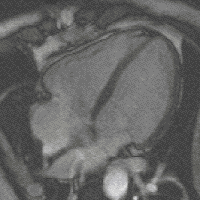
Photo from wikipedia
Brain pulsation and related CSF dynamics is a well-known intraoperative characteristic, but methods for its visualization on magnetic resonance imaging (MRI) have until now been very limited. Best characterized techniques… Click to show full abstract
Brain pulsation and related CSF dynamics is a well-known intraoperative characteristic, but methods for its visualization on magnetic resonance imaging (MRI) have until now been very limited. Best characterized techniques including phase-contrast MRI and cine echo-planar imaging, although of significant value, lack a detailed spatial and temporal resolution needed to investigate CSF and structural dynamics in an adequate manner to address preoperative decision making. Electrocardiographic (ECG)-gated true fast imaging with steady-state precession (FISP) sequences has been widely used to investigate cardiac motion and is capable of demonstrating brain pulsations and movements of intracranial structures surrounded by CSF with high temporal and spatial precision. We feature here the application of true FISP cardiac-gated imaging to the management of 2 patients with Chiari Malformation Type 1 and associated syringohydromyelia. Two children with Chiari Malformation Type 1 and concurrent syringohydromyelia underwent true FISP cardiac-gated imaging at our institution. While conventional imaging studies such as T1 and phase-contrast cine MRI appeared to demonstrate obstruction of CSF flow secondary to tonsillar herniation, true FISP showed patent peritonsillar CSF flow and the presence of a pulsatile arachnoid veil. Subsequently, open surgery confirmed the presence of an arachnoid veil, and postoperative true FISP imaging revealed restoration of CSF flow following arachnoid veil fenestration. We demonstrated 2 patients who presented with Chiari 1 malformation, where true FISP cardiac imaging was very instructive in visualizing dynamic images of an arachnoid veil and its possible role in the development of syringomyelia without a significant obstruction of outflow by cerebellar tonsils at the foramen of Magendie. We advocate use of this technology will aid in pre and post-surgical decision making, providing a more representative image of posterior fossa pathology in patients with Chiari 1 malformation.
Journal Title: Neurosurgery
Year Published: 2019
Link to full text (if available)
Share on Social Media: Sign Up to like & get
recommendations!